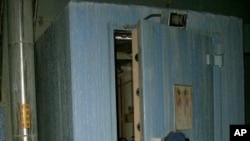Japanese officials said Monday they have fully opened a door to the building housing one of the Fukushima nuclear plant's damaged reactors to release water vapor so that workers can install a cooling system to prevent an explosion.
A spokesman for the Tokyo Electric Power Company said said the amount of radiation released by ventilating the Unit Two reactor building was too small to threaten human health.
Restoration work inside the building has been hampered by humidity of almost 100 percent caused by steam from the containment vessel and spent-fuel storage pond.
Officials say workers plan to install new water and pressure gauges for the reactor and inject nitrogen into the containment vessel to prevent a hydrogen explosion.
On Sunday, TEPCO began injecting water into a storage pool in the number four building, where contaminated equipment was being stored. Japan's national broadcaster NHK said the pool had lost two-thirds of its water, releasing large amounts of radioactivity.
The power company opened a door last month for the building housing reactor number one, and began work to build a cooling system.
However, that system failed Saturday, just five hours after the equipment came on line.
TEPCO officials said the part of the system that absorbs radioactive cesium had reached its processing capacity and needs to be replaced far sooner than expected.
A TEPCO spokesman told a news conference Saturday that the cause of the problem is being studied. He had no estimate on when the project could resume.
The water has been used to cool the plant's reactors since a nuclear meltdown after a massive earthquake and tsunami destroyed the plant's cooling systems in March. The contaminated water has been held in reservoirs at the plant, but TEPCO says those tanks are nearly full.
Company officials said Friday they plan to remove radioactive elements, oil and salt from the water and then recycle it through the reactors. But cleaning the water will create radioactive sludge, which the company will have to store.
Japan Ventilates Damaged Nuclear Reactor Building








